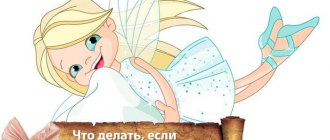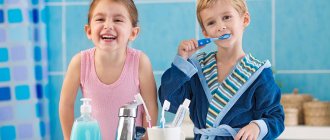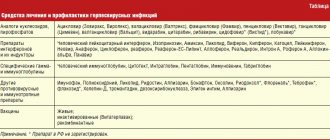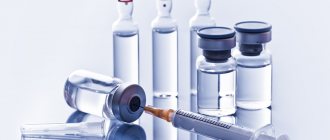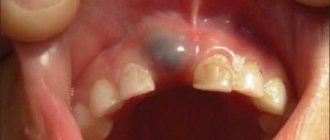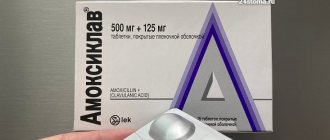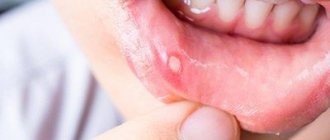Paracetamol
The most popular anti-inflammatory and pain reliever for children is Paracetamol:
| Release form | Tablets, suspension, syrup, rectal suppositories |
| Active substance | Paracetamol, sometimes in combination with ascorbic acid |
| Indications | Pain syndrome, neuralgia, myalgia, elevated body temperature |
| Contraindications | Hypersensitivity to the composition, anemia, renal dysfunction |
| Mode of application | Rectally or orally |
| Dosage | Orally – 10 mg/kg body weight, rectally – one suppository per day |
| Side effects | Nausea, abdominal pain, anemia, impaired renal function, liver function, agranulocytosis, thrombocytopenia, allergies |
| Price | 6 rubles for 10 tablets 500 mg |
Articles on the topic
- Safe cough expectorant for infants - review of drugs with descriptions
- 5 proven antipyretics for newborns - instructions for use and composition
- Pain-relieving ointments for children with bruises and injuries - effective remedies with description
Oxygen-nitrogen sedation
ZAX is a mixture of oxygen and nitrous oxide, often known as laughing gas. Served through a mask. After inhaling the gas, the child falls into a relaxed, sleepy state, calmly perceives the surrounding reality, hears and understands speech addressed to him.
- maintains a positive mood - at the same time as treatment, the child watches cartoons and gets great pleasure from it;
- neutralizes pain - the pain threshold increases, which allows you to endure dental treatment comfortably and calmly;
- reduces natural reactions - the child is no longer frightened by bright lamps and the buzzing of the drill.
Superficial ZAX sedation is recommended for patients over three years of age and, with an experienced doctor, can replace pediatric anesthesia during dental treatment.
Ibuprofen
The children's pain reliever Ibuprofen is prescribed by pediatricians for infants:
| Release form | Tablets, gel, analgesic suspension |
| Active substance | Ibuprofen |
| Indications | Arthritis, neuralgia, fever, migraine, tonsillitis, toothache, bronchitis, rhinitis, pneumonia, sinusitis |
| Contraindications | Intolerance to the components of the composition, scotoma, amblyopia, edema, hypertension, hemophilia |
| Mode of application | Orally, rectally or externally |
| Dosage | 20–40 mg/kg body per day, external course lasts 2–3 weeks |
| Side effects: | Nausea, vomiting, abdominal pain, heartburn, anorexia, diarrhea, flatulence, tachycardia, depression, drowsiness, allergic reactions |
| Price | 60 rubles for 20 tablets 400 mg |
Nurofen
Children's pain medications should safely relieve pain without causing harm to health. Nurofen is a popular disinfectant for infants:
| Release form | Suspension, candles |
| Active substance | Ibuprofen |
| Indications | Headache, toothache, neuralgia, fever |
| Contraindications | Gastric ulcer, heart failure, intolerance to the components of the composition or acetylsalicylic acid, hemophilia, hemorrhagic diathesis, low birth weight child |
| Mode of application | Orally or rectally for no longer than 3 days when used as an antipyretic and 5 days when used as an analgesic |
| Dosage | Orally – 2.5 ml of suspension 3-4 times a day, rectally – 1 suppository per day at night; for fever – 5–10 mg/kg body weight per day. For fever after immunization - 50 mg once. Shake the suspension thoroughly before use. |
| Side effects | Dizziness, anemia, renal dysfunction, diarrhea, leukopenia, allergic reactions |
| Price | 220 rubles for 200 ml of suspension |
What is anesthesia used for in pediatrics?
Until now, in the views of specialists and parents of young patients, there are still quite a lot of myths about how children perceive and experience pain.
Among such misconceptions one can find the following conclusions: children do not perceive pain the same way as adults; children do not remember the pain they experienced previously; children always tell adults when they are in pain; children always perceive pain in the same way; It is useful for children to endure pain, as it helps build character and willpower; pain relief leads to psychological dependence in the child, etc. Recent studies have shown that the younger the child, the more acutely he experiences pain, but, unfortunately, he cannot always report this21.
Pain is one of the earliest developing psychophysical functions associated with the most “ancient” structures of the brain. By 30 weeks of fetal development, all pathways for conducting and perceiving pain have already been formed. From this time on, the child perceives pain, and its intensity is often even greater than in adults.
However, the subjective nature of pain makes it a difficult concept to measure. This is especially true for those who find it difficult to express their pain in words. As a result, according to the researchers, until the early 1980s, pain in newborns was rarely treated adequately, because It was assumed that due to the immature nervous system, infants are practically unfamiliar with pain. The work of Anand et al showed that in premature newborns after surgery with conventional minimal anesthesia, stronger reactions occurred (increased concentrations of catecholamines, glucagon, corticosteroids), they experienced more postoperative complications, and higher mortality compared to the group of newborns who received complete anesthesia . McCrath and Unruh showed that the immaturity of newborns relates not to their ability to experience pain, but to the exceptionality of their inability to signal it to adults.
Currently available evidence allows professionals to urge the provision of pain management to children of all ages, if only because all human beings have the right to adequate pain control, whether they can report it or not.
It is also worth considering that the general perception of treatment and illness by an adult patient and a child is different. An adult is able to appreciate the benefits of treatment procedures and medical manipulations and positively perceive the treatment situation and medical personnel, despite the pain and discomfort experienced. A child’s thinking (up to approximately early adolescence) is concrete, visual, and more fragmented. Thus, a large randomized study showed that children of almost all ages consider needles and the procedures associated with their use to be the most frightening and painful component of a visit to the doctor.
Due to the deficit of semantic regulation, emotions and sensations play a large role in assessing the situation and adapting to it.
Therefore, therapeutic and preventive medical procedures associated with painful sensations or diseases accompanied by pain are often associated in children with punishment and violence. Children often feel guilty for their own poor health, regarding this as a manifestation of their own “badness.” Even children who cannot yet speak remember very well all the details of painful procedures and events. When the procedure is repeated, they experience an increase in the “stress” reaction already at the time of treating the skin before the procedure. Negative experiences can intensify the pain response time after time, like a snowball, determining the child’s further response to painful stimuli.
Memory forces the body to avoid those situations that, thanks to the experience of pain, have acquired the meaning of “dangerous” in the child’s life. If this pain is the result of medical procedures, treatment, or illness, then such avoidance is called “medical PTSD syndrome.” A well-known manifestation of this disorder is “needle phobia,” familiar to many adults.
Despite the fact that pain has a signaling function, indicating a problem, damage in the body, mobilizing the body's reserve forces to ensure the reaction of flight and defense, its “positive” meaning is often extremely exaggerated. Pain calls for help and treatment. From a psychological point of view, enduring pain is not only useless, but also harmful.
Pain worsens the quality of life (perception of opportunities and fullness of life) of children of different ages and with various diseases, and in cases of various medical procedures. Thus, in adolescents with arthritis, high levels of pain led to a decrease in quality of life indicators such as physical, emotional and social functioning. Children with chronic abdominal pain of nonorganic origin, as well as children with gastroisophagitis or inflammatory bowel disease accompanied by pain, experience a decrease in quality of life in all respects compared to healthy peers. Pain has pronounced negative effects: both short-term and delayed.
Some authors, depending on the severity of the reaction and the duration of the consequences in response to medical situations and diseases accompanied by various pains, divide acute stress disorder (OST) and post-traumatic stress disorder (PTSD). The first (OST) is characterized predominantly by dissociation, avoidant behavior, anxiety and excitability, obsessive repetition of experiences, symptoms last from 2 days to 4 weeks and gradually fade away. The second (PTSD) is also characterized by repetition of the experience, avoidant behavior, and increased excitability, but the symptoms last for at least one month. According to ICD-10 and DSM-IV, post-traumatic stress disorder is classified as an anxiety disorder. Depending on age, the ability to cope with traumatic pain experiences, the characteristics of medical situations, children’s reactions may be different. Infants and young children show signs of regressive behavior, whining, enuresis, loss of newly acquired skills, loss of speech, difficulty falling asleep or waking up at night. Children of preschool age strive to reproduce their experiences in games; along with this, difficulties in falling asleep and nightmares, a decrease in speech activity, increased separation anxiety (when parting with loved ones), as well as fears, for example, fear of the dark, may also appear. Children of primary school age demonstrate nightmares, fixation on a traumatic event, obsessive repetitions, various psychosomatic reactions, overexcitation, inappropriate emotional reactions, fears, avoidant behavior, and aggressive attacks. In adulthood, a desire for greater independence may appear - early sexual relations, the desire to leave home - or, conversely, an age-inappropriate increase in dependence. Deviant behavior and use of psychoactive substances are also possible. Teenagers are more likely to experience feelings of guilt and intrusive memories than younger children.
At any age, a child, faced with the experience of pain, often loses interest in ordinary activities, his self-esteem decreases, and his prospects for the future are often lost. Such experiences can upset relationships with loved ones and friends, especially if the pain is associated with life-saving procedures or a serious illness, or violence.
In turn, the consequences of PTSD can lead to disruption of the child’s adaptation at school, usual life and environment. Different types of traumatic situations associated with painful experiences in children were compared: type I traumatic situations associated with sudden events (fire, accidents with injuries, various medical procedures) and type II situations associated with prolonged exposure to an unpleasant event (cancer disease, organ transplantation). ). Both cases were characterized by avoidant behavior in children, increased anxiety, and repetition of situations. For children with type I trauma, complete detailed memorization of the situation, the development of premonitions, and impaired perception of reality were more typical, while children with type II trauma demonstrated greater denial of the situation, dissociation, and lack of feelings or problems. In response to medical procedures, both type I responses can develop (if the procedures involve dangerous interventions) and type II (if more painful procedures are repeated many times, and the treatment itself is lengthy and aggressive).
The various psychological consequences of pain experience in children are analyzed depending on the experience and the context of various diseases. The painful experience associated with burns often provokes nightmares, enuresis, and phobias in children for a year or even more after the accident. Painful experience associated with injuries and car accidents leads to the fact that children are worse at differentiating fear, whether it is associated with the accident itself or with painful procedures during treatment. Replaying of traumatic situations, reproducing the situation in dreams, and avoidant behavior were noted.
In response to surgery, which is accompanied by painful experiences, more than 80% of children and their families experience acute stress. Such trauma provokes fears, depression, and generalized anxiety. One in five children develop post-traumatic stress disorder that lasts more than 4 months and manifests itself in everyday life. Much of this stress is triggered by the level of pain experienced during illness and treatment. More severe early stress (acute stress reaction) in children and parents may help prevent the development of post-traumatic stress in children. Particular attention is paid to the influence of pain in children with cancer. Increased severity of PTSD symptoms, compared with other conditions, is associated with length of treatment, painful interventions, and intensity of treatment. Especially in young children, the association of PTSD with subjective treatment measures increased.
Data from the US Center for Pediatric Traumatic Stress (Philadelphia) also confirm that the experience of pain in children can have significant negative short-term and long-term psychological and social consequences . Among the psychological consequences in adult life are: chronic pain disorder, anxiety, various phobias, hypochondriacal personality development, panic attacks. Among the social ones are reactions of avoidant and evasive behavior from new and unfamiliar situations, which significantly reduce the level of social adaptation. Significant social and emotional problems in the case of pain in childhood are experienced not only by children, but also by their parents.
Some chronic and acute diseases of children, accompanied by pain, unfortunately, end in death. In such cases, the fact that the child suffered less and suffered less pain before death can be crucial for the family in terms of rehabilitation and coping with the loss of the child. Reducing pain experiences reduces the severity of medical stress in children and their families (...).
Currently, to control pain of various origins, special protocols for pain assessment and treatment have been developed and continue to be developed. Their main component is the use of various medicinal methods of pain relief (..). To control pain in children, non-pharmacological and psychotherapeutic methods of assistance are also used.
In some cases, these methods can be carried out by parents and medical staff (and sometimes by the children themselves), specially trained in special techniques; in others, by experienced psychologists and psychotherapists. One of the groups of such methods is associated with the creation of a special environment in which medical manipulations with a child take place, accompanied by pain. Typically, step-by-step information is used to inform the young patient and parent about what will happen during the procedure, what the child will see and hear. At the same time, it is recommended to avoid incomprehensible medical terms, highly disturbing and emotionally charged words, and not to try to convince that the procedure will be absolutely painless. The use of jokes, clear commands, praising the child, reading books describing the procedure, and sincere and open communication have a positive impact during the procedures. Additional comfort for children can be created due to the appearance of the room where procedures and manipulations are carried out, where toys or a cute blanket are placed, walls are painted and pictures are hung. It is also useful to include the smallest patient in the procedure: the child can be asked, for example, to count down the time until the end of certain stages of the procedure or to hold some medical instrument; It is important to give the child a sense of freedom, for example, by choosing a particular bandage, deciding which hand to take the test from, etc. If a child is hospitalized and undergoing treatment in a hospital, it is not recommended to carry out procedures in the ward, on his crib. It is better to use a special room for manipulations in order to maintain the child’s feeling of safety at least in his room. It is important to respect its boundaries, emphasized by the presence of a schedule of procedures and activities, accompanying rounds with a preliminary knock on the door of the ward where the child is.
Parents who remain with them can reduce pain and distress in children; they can also learn from them what may be stressful for their child in the procedure and what can help them better cope with the situation. However, it is important not to ask parents to restrain the child, to instruct parents not to threaten the child with additional injections, but, on the contrary, to set them the task of behaving in such a way as to help “hold back” the pain. To achieve this, various methods of distracting the child during the procedure in different ways are widely used, depending on the child’s age, hobbies and interests. Distracting conversations (about school, hobbies) are always available. For infants, physical contact between mother and baby, for example, pressing him to the mother's breast, is often used as a distraction during the procedure. Tactile distraction is also used with older children: using pressure on some point of the body, stroking, patting.
Among the recommendations for similar control of pain in children for medical personnel are the following: conduct activities in a calm and friendly atmosphere; be confident and avoid apologies, excuses, criticism; avoid conversations with colleagues, parents, students (especially about side effects of the procedure); try to avoid stressful influences (sharp sounds); Do not play it safe during procedures. For this purpose, special trainings and seminars are organized for staff.
Cognitive (behavioral) psychotherapy can be used to combat post-traumatic stress syndrome To prevent and treat medical stress, it is proposed to provide information to children and parents of the patient about the disease, the causes of pain and painful procedures; early diagnosis of pain response; raising the level of awareness of specialists themselves, including on the problems of children experiencing pain and ensuring pain management.
Thus, it becomes obvious that the problem of pain in pediatrics currently occupies a special place. Childhood experiences can make a person more or less susceptible to pain. Lack of pain relief and pain treatment can have serious negative consequences for the development of a harmonious and well-adjusted personality, as well as the establishment of a doctor-patient partnership in adult life21.
Tantum Verde
Tantum Verde is considered a safe pain reliever for infants:
| Release form | Spray, solution, lozenges |
| Active substance | Benzydamine |
| Indications | Pharyngitis, gingivitis, stomatitis, tonsillitis, inflammation of the oral mucosa, phlebitis |
| Contraindications | Hypersensitivity to the components of the product, lack of muscle mass, gastrointestinal disorders |
| Mode of application | Inside, locally, externally |
| Dosage | Spray – 1–4 doses per day, solution – 1.5 ml for irrigation of the oral mucosa, tablets – 1 pc., 3–4 times a day |
| Side effects | Burning sensation, dry mouth, numbness, laryngospasm, skin allergies |
| Price | 270 rubles for 20 tablets 3 mg |
About the correct prevention of colic
To prevent colic, you need to do gymnastics with your baby.
Any disease is easier to prevent than to cure. This statement is also true in relation to infant colic.
It is known that the formation of microflora in a child’s intestines begins even before birth.
Therefore, in order for the baby not to suffer from gastrointestinal problems, his mother needs to eat properly throughout pregnancy.
Otipax
To treat ear problems in infants, Otipax drops are used:
| Release form | Ear drops |
| Active substance | Lidocaine, phenazone |
| Indications | Acute, inflammatory moderate, barotraumatic otitis, complications after influenza |
| Contraindications | Perforation of the eardrum, hypersensitivity to the components of the composition |
| Mode of application | Instillation of a pre-warmed (between the palms) product into the external auditory canal for no longer than 10 days |
| Dosage | 3-4 drops 2-3 times a day |
| Side effects | Allergy, irritation, skin hyperemia |
| Price | 210 rubles for 15 ml |
Enzyme-enriched preparations
Enzymes are special substances that help break down nutrients (in particular milk sugar) in the intestines.
Modern medicines mainly contain digestion catalysts such as amylases, lipases and proteases. Of all the drugs containing enzymes, infants are most often prescribed:
- Mezim;
- Creon;
- Lactazar (the latter is recommended exclusively for lactose deficiency and may be completely useless in all other cases).

